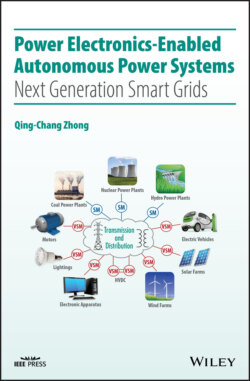Читать книгу Power Electronics-Enabled Autonomous Power Systems - Qing-Chang Zhong - Страница 13
Preface
ОглавлениеElectrification is the greatest engineering achievement of the 20th century and power systems are arguably the most important infrastructure that underpins social life and economic growth. The generation of electricity has been dominated by centralized large power plants, but the landscape of power systems is fast changing. Large centralized power plants are being replaced with incompatible, non‐synchronous, and relatively small distributed energy resources (DERs), electric vehicles (EVs), and storage systems, which is often referred to as the democratization of power systems. This is comparable to the great historical event of personal computers replacing mainframes in the technology domain or republics replacing monarchies in the political domain. The number of active players, including DER units and storage units etc., is rapidly growing and could easily reach millions. This brings unprecedented challenges to grid stability, reliability, security, and resiliency. The fundamental challenge is that future power systems will be power electronics based, instead of electrical machines based, with millions of non‐synchronous heterogeneous players. This is less of a power problem but more of a systems problem – power systems are going through a paradigm shift.
Adding an ICT (information and communications technology) system into power systems, hence the birth of smart grids, has emerged as a potential solution. However, this could lead to serious reliability concerns. On 1 April 2019, a computer outage of Aerodata affected all major US airlines, causing 3000+ flight cancellations or delays. This sends a clear warning to the power industry: ICT systems may be a single point of failure and similar system‐wide outages could happen to power systems. Moreover, when the number of active players reaches a certain level, the management of ICT systems is itself a challenge. What is even worse is that adding ICT systems to power systems opens the door for potential cyber‐attacks by anybody, at any time, from anywhere. There are numerous reports about this and, on 23 December 2015, hackers compromised ICT systems of three distribution companies in Ukraine and disrupted the electricity supply to 230 000 customers. The reliance of power systems operation on ICT systems has become a fundamental systemic flaw.
Another fundamental systemic flaw of current power systems is that a local fault can lead to cascading failures. On 16 June 2019, a blackout originating in Argentina's northeast struck all of Argentina and Uruguay, and parts of Brazil, Chile and Paraguay. There is a pressing demand to prevent local faults from cascading into wide‐area blackouts.
This book summarizes the author's profound thinking into these problems over the last 18 years and presents a theoretical framework, together with its underpinning technologies and case studies, for future power systems with up to 100% penetration of DERs to achieve harmonious interaction, to prevent local faults from cascading into wide‐area blackouts, and to operate autonomously without relying on ICT systems. Thus, it is possible to completely avoid cyber‐attacks. The theoretical framework, referred to as SYNDEM (meaning synchronized and democratized), adopts the synchronization mechanism of synchronous machines, which has underpinned power systems operation and growth for over 100 years, as its rule of law. Hence, the SYNDEM framework brings backward compatibility to current power systems. The underpinning technologies will turn power electronic converters into virtual synchronous machines (VSMs) and achieve legal equality among millions of non‐synchronous heterogeneous players, including flexible loads that have power electronic converters at the front end. This unifies and harmonizes their interface and integration with the grid, making it possible to achieve autonomous operation for power systems without relying on ICT systems. Hence, the SYNDEM theoretical framework and its underpinning technologies will significantly smooth the paradigm shift of power systems from the centralized control of a small number of large facilities to democratized interaction of a large number of relatively small generators and flexible loads, accelerating the large‐scale adoption of renewables while enhancing grid stability, reliability, security, and resiliency.
This book consists of one introductory chapter (Chapter 1) and five parts: Theoretical Framework (Chapters 2–3), First‐Generation VSMs (Chapters 4–14), Second‐Generation VSMs (Chapters 15–20), Third‐Generation VSMs (Chapter 21), and Case Studies (Chapters 22–25). In the introductory chapter, the outline of the book and the evolution of power systems are presented. In Part I, the SYNDEM theoretical framework and the ghost power theory are presented. In Part II, the first‐generation VSMs (synchronverters) are presented, together with their application in wind power, solar power, flexible loads, STATCOM, and motor drives, the removal of PLLs, the improvement to bound frequency and voltage, and the reconfiguration of virtual inertia, virtual damping, and fault ride‐through. In Part III, the equivalence between droop control and the synchronization mechanism is established at first. Then, the second‐generation VSMs (robust droop controllers) are presented, followed by universal droop control, the removal of PLLs, droop‐controlled flexible loads to provide continuous demand response, and current limiting converters to prevent cascading failure. In Part IV, the third‐generation VSM, which achieves passivity of itself and the whole system if it is open‐loop passive, is presented. In Part V, four case studies are presented, including a single‐node system based on a reconfigurable SYNDEM smart grid research and educational kit, a 100% power electronics based SYNDEM smart grid testbed, a home grid, and the Panhandle wind power system.
This book is suitable for graduate students, researchers, and engineers in control engineering, power electronics, and power systems. The SYNDEM theoretical framework chapter is also suitable for policy makers, legislators, entrepreneurs, commissioners of utility commissions, utility personnel, investors, consultants, and attorneys. The book covers various challenging problems in the control of power electronic converters, distributed generation, wind power integration, solar power integration, microgrids, smart grids, flexible AC transmission systems, etc. It can be also adopted as a textbook for relevant graduate programs. Actually, it has been adopted as the textbook for ECE 537–Next Generation Smart Grids at Illinois Institute of Technology since 2018.
